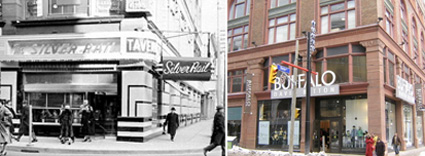The End of Toronto’s Dry Spell

Today, it’s a clothing store where, if you’re lucky, you may score up to 70 per cent off designer jeans.
On April 2, 1947, however, the regal brown building on the northeast corner of Yonge and Shuter streets in Toronto was decked out in sleek art deco style, with clean black and white lines that ran along the exterior wall like an arm beckoning you inside. On a metallic sign that sliced across the marquee above the door like the blade of a freshly sharpened skate, the words The Silver Rail glistened as a symbol of a new era in Ontario.
The Ontario Temperance Act, a very neat and official term for prohibition, became law in 1916 and, for all intents and purposes, dried the province up (that’s, of course, if you ignore the existence of those bootlegging rascals who smuggled booze into our pious towns).
A series of political and legal battles in the ensuing years after the First World War helped to peel the provincial prohibition laws back layer by dry layer until beer and spirits were available in certain licensed taverns in the 1930s. Of course, while you could finally get a drink without the anxiety of getting nabbed by the long arm of the law, these bars weren’t always the classiest of joints.
Then, in early April 1947, changes in the law allowed for the opening of the first licenced cocktail lounges in Toronto. Finally, you could order a Manhattan, a beer or a Scotch on the rocks with dinner. The Silver Rail, which was one of the first cocktail lounges to open in the city, became instantly popular for its two-floor layout of classy restaurant dining booths and a stylish bar for those simply looking for a drink or two.
According to a heritage plaque that once stood in front of the building, “Curious Torontonians would ride the streetcar along Yonge Street to catch a glimpse of patrons lined up, waiting to enter. For the first time in Toronto, it was possible for diners to drink a glass of wine or enjoy a cocktail with a fine meal -. The Silver Rail is an early example of mixed use, incorporating a bar upstairs and a restaurant downstairs. It became a central fixture of downtown Toronto nightlife.”
Sadly, The Silver Rail closed in its 50th year, making way for clothing stores and home decor depots. Still, for those who remember dining with a date or stopping in after a downtown shopping spree, the old brown building will always be a reminder of the time the province left its driest days behind.
-Mike Crisolago